
Yonge Street is a major arterial route in the Canadian province of Ontario connecting the shores of Lake Ontario in Toronto to Lake Simcoe, a gateway to the Upper Great Lakes. Ontario's first colonial administrator, John Graves Simcoe, named the street for his friend Sir George Yonge, an expert on ancient Roman roads.

Yonge–Dundas Square, or Dundas Square is a public square at the southeast corner of the intersection of Yonge Street and Dundas Street East in Downtown Toronto, Ontario, Canada. Designed by Brown and Storey Architects, the square was conceived in 1997 as part of revitalizing the intersection. Since its completion in 2002, the square has hosted many public events, performances and art displays, establishing itself as a prominent landmark in Toronto and one of the city's prime tourist attractions. Central to the Downtown Yonge entertainment and shopping district, the square is owned by the city and is the first public square in Canada to be maintained through a public–private partnership. The intersection is one of the busiest in Canada, with over 100,000 people crossing the city's first pedestrian scramble daily.
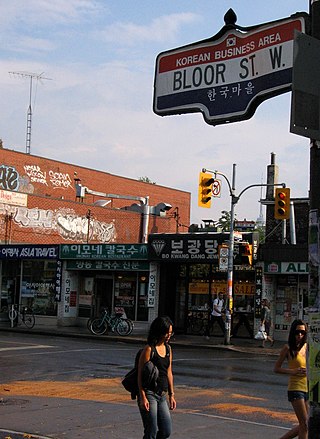
Koreatown is an ethnic enclave within Seaton Village, a neighbourhood of Toronto, Ontario, Canada. Located along Bloor Street between Christie and Bathurst Streets, the area is known for its Korean business and restaurants. The ethnic enclave developed during the 1970s, as the city experienced an influx of Korean immigrants settling in Toronto. Toronto has the largest single concentration of Koreans in Canada with 53,940 living in the city, according to the Canada 2016 Census.
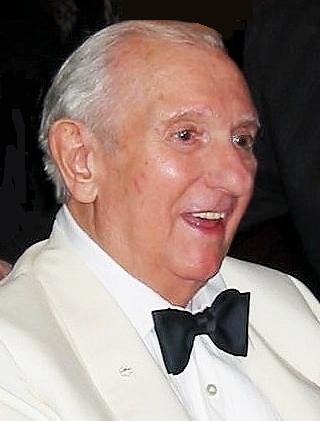
Yehuda Edwin "Honest Ed" Mirvish, was an American-Canadian businessman, philanthropist and theatrical impresario who lived in Toronto, Ontario. He is known for his flagship business, Honest Ed's, a landmark discount store in downtown Toronto, and as a patron of the arts, instrumental in revitalizing the theatre scene in Toronto.

Honest Ed's was a landmark discount store in Toronto, Ontario, Canada. It was named for its proprietor, Ed Mirvish, who opened the store in 1948 and oversaw its operations for almost 60 years until his death in 2007. The store continued to operate until it permanently closed on December 31, 2016.
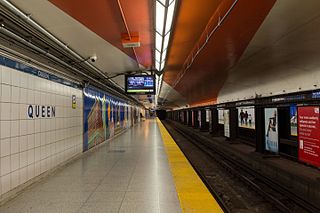
Queen is a subway station on Line 1 Yonge–University in Toronto, Ontario, Canada. It is located under Yonge Street north from Queen Street to Shuter Street. Wi-Fi service is available at this station.

Dundas is a subway station on Line 1 Yonge–University in Toronto, Ontario, Canada. It is located at the intersection of Yonge Street and Dundas Street. Wi-Fi service is available at this station.

Wellesley is a subway station on Line 1 Yonge–University in Toronto, Ontario, Canada. It is located on Wellesley Street East, east of Yonge Street. Wi-Fi service is available at this station.
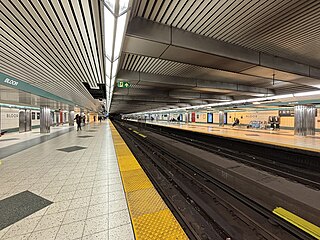
Bloor–Yonge is a subway station on Line 1 Yonge–University and Line 2 Bloor–Danforth in Toronto, Ontario, Canada. Located in Downtown Toronto, under the intersection of Yonge Street and Bloor Street, it is the busiest subway station in the system, handling over 200,000 passengers on an average weekday. Wi-Fi is available at this station.
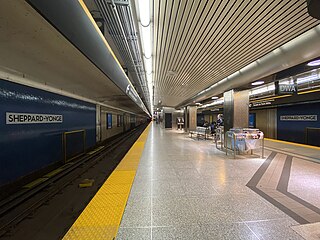
Sheppard–Yonge is an interchange station on Line 1 Yonge–University and Line 4 Sheppard of the Toronto subway. The station is located at the southern end of North York City Centre. It is the fourth-busiest station in the system, after Bloor–Yonge, St. George and Union, serving a combined total of approximately 134,076 people per day in 2019.

Bathurst is a subway station on Line 2 Bloor–Danforth in Toronto, Ontario, Canada. The station, which opened in 1966, is located on Bathurst Street just north of Bloor Street West. It is a major transfer point for both bus and streetcar routes, including the 511 Bathurst route, which provides services to Exhibition Place.

The Elgin & Winter Garden Theatres are a pair of stacked theatres in Toronto, Ontario, Canada. The Winter Garden Theatre is seven storeys above the Elgin Theatre. They are the last surviving Edwardian stacked theatres in the world.

The Ed Mirvish Theatre is a historic performing arts theatre in Toronto, Ontario, located near Yonge–Dundas Square. Owned and operated by Mirvish Productions, the theatre has approximately 2,300 seats across two levels. There are two entrances to the theatre, located at 263 Yonge Street and 244 Victoria Street.
Famous Players Limited Partnership was a Canadian-based subsidiary of Cineplex Entertainment. As an independent company, it existed as a film exhibitor and cable television service provider. Famous Players operated numerous movie theatre locations in Canada from British Columbia to Newfoundland and Labrador. The company was owned by Viacom Canada but was sold to Cineplex Galaxy LP in 2005.

Downtown Toronto is the main central business district of Toronto, Ontario, Canada. Located entirely within the district of Old Toronto, it is approximately 16.6 square kilometres in area, bounded by Bloor Street to the northeast and Dupont Street to the northwest, Lake Ontario to the south, the Don Valley to the east, and Bathurst Street to the west. It is also the home of the municipal government of Toronto and the Government of Ontario.

The University Theatre was a single-screen cinema located at 100 Bloor Street West along the Mink Mile, just west of Bay Street in Toronto, Ontario, Canada. The area was once home to a number of cinemas, most notably the Uptown Theatre.

The Toronto Theatre District is a part of the Toronto Entertainment District in Downtown Toronto that contains the largest concentration of stage theatres in Canada. It is the third largest English-speaking theatre district in the world, after West End in London and Broadway in New York City.
Mirvish+Gehry, also known as Forma, is a planned two-tower mixed-use building complex in Toronto, Ontario, Canada. The towers were designed by Frank Gehry in partnership with David Mirvish. The project is located on King Street West at Duncan Street in Toronto's Entertainment District.
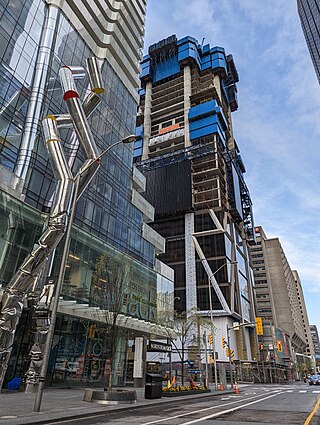
The One is a supertall skyscraper currently under construction in Toronto, Ontario, Canada. If completed, it will be the tallest building in Canada. At 328.4 metres and 91 storeys, it will be taller than First Canadian Place, which has been Canada's tallest building since 1975. It will also be Canada's first supertall skyscraper, as defined by the Council on Tall Buildings and Urban Habitat. Construction of the building is estimated to be completed by March 2025.




















